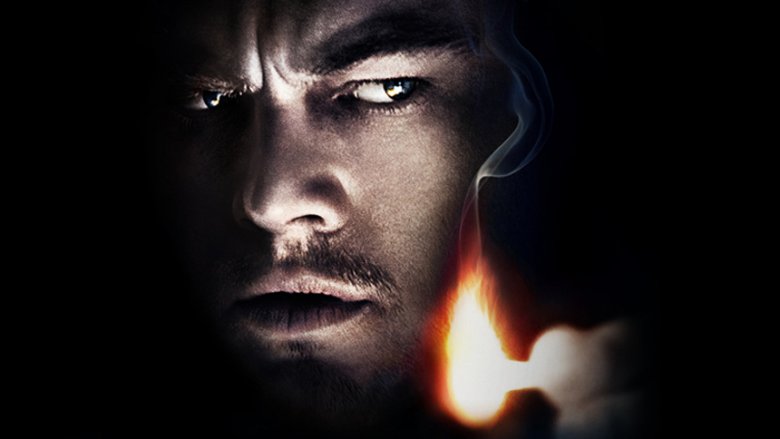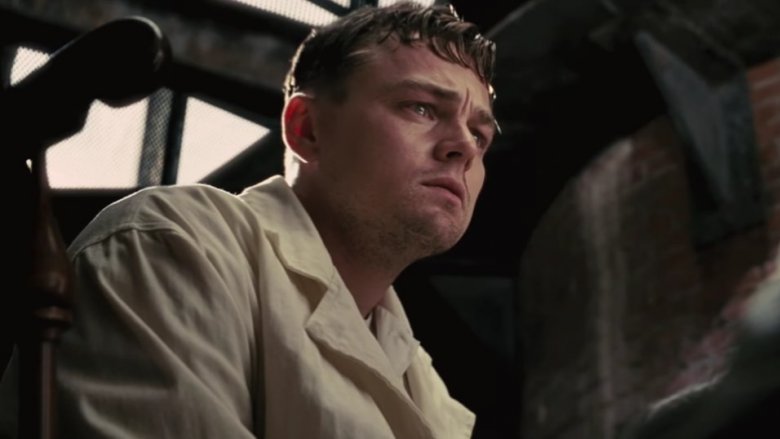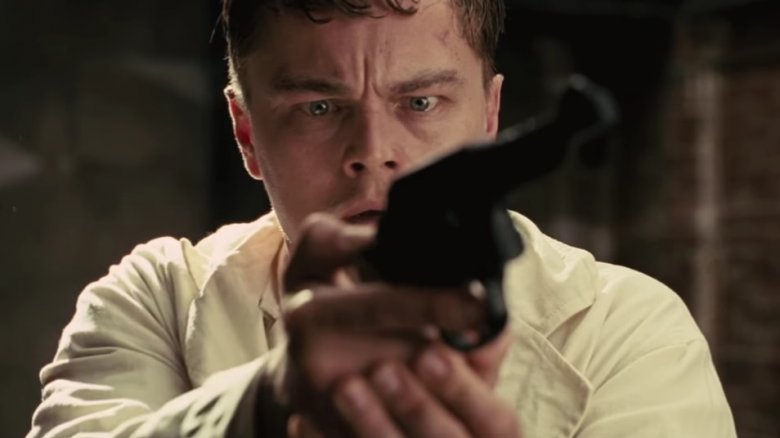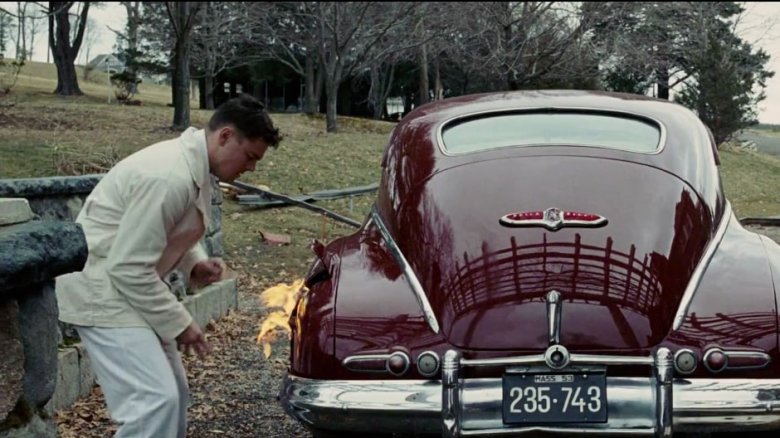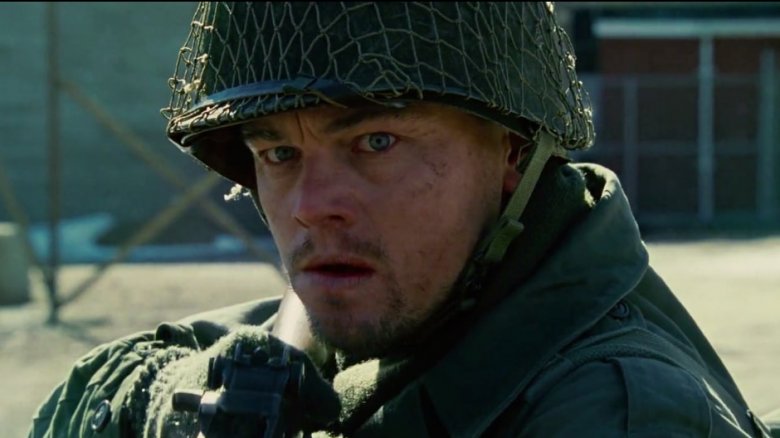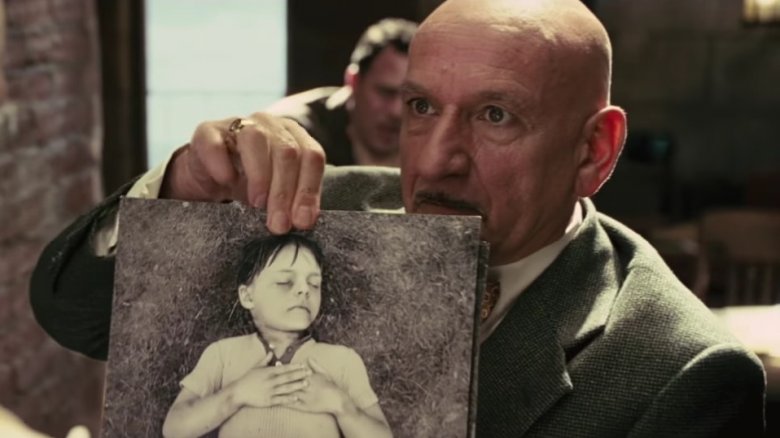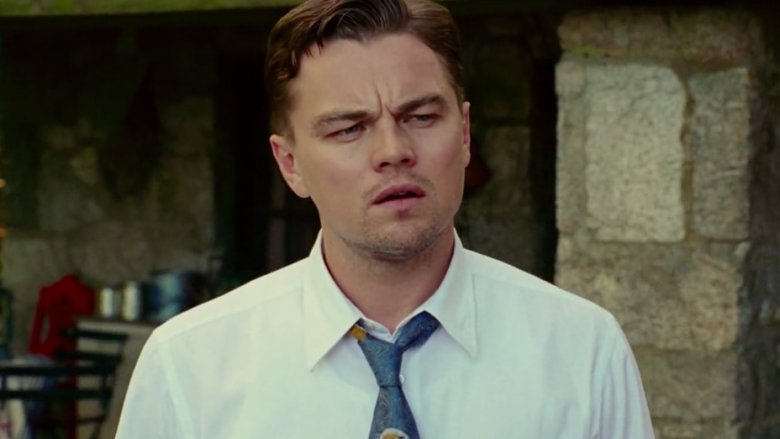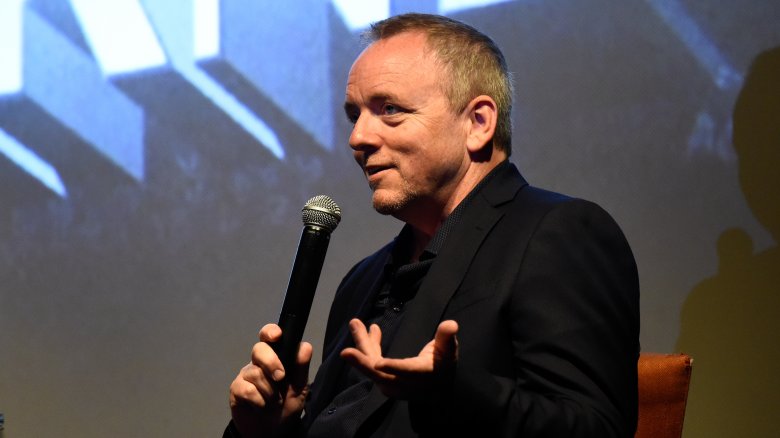The Ending Of Shutter Island Explained
Martin Scorsese wasn't kidding when he said that his neo-noir psychological thriller Shutter Island—based on Dennis Lehane's 2003 novel of the same name—would be twice as profitable because moviegoers would have to see it twice just to understand the ending. Nevertheless, he may have underestimated. Even after more than two viewings, it's still hard to definitively conclude just what exactly is going down on the titular island, and whether or not Leonardo DiCaprio's character is actually the mental case the film's supporting cast leads us to believe.
The jury is still out on Shutter Island's correct interpretation, and the debate surrounding the film's ending still rages today. But fear not! We're here to correctly diagnose what's wrong amidst all of the insanity, and we've got plenty of evidence to back it all. But don't merely take our word for it. See for yourself...
It probably goes without saying, but we'll say it anyway: what follows is one massive spoiler on top of more massive spoilers.
Teddy is being brainwashed
First and foremost, let's get one thing straight: Leonardo DiCaprio's character—whom we'll hereafter refer to as "Teddy"—is being brainwashed.
Now, that's not to say that Teddy isn't crazy. Or that he was right about everything. Or that he really was a U.S. Marshal. (We'll get to all that stuff later.) Rather, what we see play out throughout the film is indeed an elaborate role-play in which the doctors at Shutter Island aggressively attempt to implant a specific memory into Teddy's mind—namely, that he is actually a man by the name of Andrew Laeddis who compassionately murdered his psychotic wife after she drowned their three children. Of course, the doctors are unsuccessful, as Teddy's repeated relapses indicate that he systematically rejects the memory as not being his. Nevertheless, Teddy is actively being brainwashed—sanity aside.
The real question, however, pertains to whether or not that specific memory—in which Teddy kills his psychotic wife after she drowns their three children—is actually Teddy's. The film certainly invites viewers to accept the ending at face value, leading many to incorrectly assume that Teddy definitely did shoot his wife at their lake house and simply refuses to acknowledge the painful memory, despite the medical team's best efforts. Upon closer inspection, however, there's good reason to suspect that the memory in question isn't really Teddy's.
Teddy is not a U.S. Marshal
Before we get deeper into Shutter Island's shady attempt at brainwashing Teddy, however, it's important to clear up another important plot point: Teddy is definitely not a U.S. Marshal.
The evidence supporting this claim is staggering and obvious. We first know something might be amiss when Teddy, while perturbed by Dr. Cawley's unwillingness to cooperate with the investigation, states that he and his partner are "going to file our reports and hand it over to..." but fails to recall the federal chain of command. It doesn't take a U.S. Marshal to know that he's is referring to the Federal Bureau of Investigation, and Dr. Sheehan—who is most certainly not a U.S. Marshal—completes Teddy's sentence with the FBI's nickname: "Hoover's boys." Strange that a veteran U.S. Marshal would struggle to recall to whom exactly he files his reports, no? But hey, migraines can be incapacitating!
While failing to recall the FBI might be excusable, failing to recognize the difference between a real, metal handgun and a cheap, easily-breakable plastic toy is not. Any U.S. Marshal worth his badge would surely recognize the correct weight of a revolver as soon as they pick it up, but Teddy actually goes so far as to claim he knows the gun is loaded on account of its weight, and that "his initials are on the side and there's a dent in the barrel from when Philip Stacks shot at me." Yet he snaps it like a twig.
Sorry, Ted—you're just playing cowboy.
He's a pyromaniac
So, if Teddy isn't really a U.S. Marshal... who is he?
Teddy is quite obviously a patient at Shutter Island and is almost certainly the pyromaniac responsible for the deaths of his wife and three other people. The most telling piece of evidence comes when Teddy dreams of "Andrew Laeddis," the firebug supposedly responsible for burning down his apartment complex. During this sequence, we get a close-up shot of a clearly fictional Laeddis' hands lighting a match. Interestingly, we are presented with the exact same shot when Teddy lights a match later in the film, and even the movie's promotional cover art is a close-up of DiCaprio's face behind a lit match.
Add in the fact that Teddy is adept at creating quick, on-the-fly car bombs, and you've got more than enough reason to suspect that Teddy is actually the pyromaniac responsible for burning down his apartment complex.
He has PTSD
Teddy probably turned into the pyromaniac responsible for killing his wife as a result of traumatic experiences that took place during his service in World War II.
While overseas, we know that Teddy witnessed the death toll of a WWII concentration camp, was part of a squad responsible for "murdering" dozens of disarmed Nazis, and was face to face with the results of a failed suicide attempt. These events have clearly taken a toll on Teddy, who dreams about them on an almost nightly basis. Such recurring nightmares are a clear sign of some serious PTSD, which may have driven Teddy to burn down his apartment in a fit of insanity.
Because of his extreme guilt and inability to accept the crimes he has committed, Teddy chose to manufacture a false reality—as explained by Dr. Cawley and Dr. Sheehan—in which he is a U.S. Marshal on the hunt for his wife's killer. In this way, Teddy is indeed mentally unstable and certifiably committable. He clearly needs mental treatment.
Still, he ain't no "Andrew Laeddis," and the pair of doctors aren't actually "treating" him. They're experimenting on him.
But Teddy's right: Shutter Island is a government conspiracy
While it's easy to take Shutter Island's big twist and ending at face value, it's a mistake to discount the fact that everything about the location itself is super shady.
Just because Teddy has created a false narrative for himself doesn't mean that he's created a false narrative for the secretive, isolated mental institution. "They're experimenting on people here," Teddy tells "Chuck," his fake partner who is actually one Dr. Sheehan, and thus knows the truth of it. Sheehan tries to dismiss Teddy's theory... but Teddy's got it figured out. "That's the beauty of it, isn't it? Crazy people, they're the perfect subjects," he says. "They talk, nobody listens. I stood at Dachau. We saw what human beings are capable of doing to each other, right? For Christ's sake, we fought a goddamn war to stop them and now I found out it may be happening here? On our soil?"
Teddy might be crazy, but he isn't wrong. Everything about Shutter Island "reeks of government ops." The guards carry military-grade rifles and drive military-grade vehicles. The most dangerous "patients" are housed in an old Civil War fort. All of the facilities are surrounded by an electrified fence, lighthouse included. If there was ever an opportunity to conduct government-sanctioned mind control experiments, a secret, isolated prison for the "criminally insane" would be the perfect place. Who'd ever find out?
Teddy, of course, figures it out... but what can he do about it? After all, he's the subject of a mind-control experiment himself.
The lake house memory isn't real
Although Teddy has created a false reality for himself—in which he is a "good guy" looking to track down his wife's killer and expose the truth about the U.S. government's mind control experiments taking place at Shutter Island—there's no reason to assume the doctors are presenting him the truth. Rather, it's highly probable that they are conducting an elaborate mind-control experiment on Teddy, in an attempt at implanting a false memory into his already troubled brain. (For science!)
The false memory in question, of course, is the film's pivotal lake house scene. In this fictional scene, Teddy comes home from his job (as a U.S. Marshal) to find that his mentally-ill wife has drowned their three children in an attempt at turning them into "living dolls." Teddy then shoots his wife out an emotional act of compassion, as she begs for him to "set her free." The scene is deep. It's dark. And it's entirely fake.
At face value, the lake house scene serves to illustrate why Teddy is at Shutter Island in the first place, so it's easy for the audience to fall victim to the doctor's mind control. It all "makes sense," right? The problem is, it doesn't all add up. It's not real. The entire memory is either fabricated or someone else's story, and the good doctors Cawley and Sheehan are aggressively attempting to implant this memory into Teddy's brain.
Not buying it? No problem! Let's take a look at the evidence...
Teddy never had any children
The first piece of evidence suggesting that Teddy was the subject of an elaborate brainwashing experiment involves his supposedly having children.
Not once in the film does Teddy talk about his children. In fact, he never mentions his children at all, even when recalling the fact that his wife died in a fire that killed four people. Isn't it a bit odd that he wouldn't describe the arson as killing both his wife and children—i.e., his entire family? Even stranger, Teddy never once recalls the faces of his sons in any of his dreams, memories, or visions. The only one of his supposed children's faces we ever actually see is his daughter, who first shows up in a dream as a frozen body in Dachau—which is probably where he really saw her.
The only suggestion that Teddy ever had children comes from Dr. Cawley... and why should we believe him? Despite Teddy's insistence that he "never had any children," Cawley forces pictures of three drowned children on him, telling Teddy their supposed names and reminding him that he dreams about the little girl every night. (In truth, he dreams about Dachau every night.) Teddy rejects it in sincere confusion, saying "I never had a little girl..." and he probably didn't. Dr. Cawley is merely trying to implant—in the name of science—an altogether different false reality into Teddy's already confused brain.
Why are you all wet, baby?
A close analysis of the lake house scene itself finds some major faults in the story.
Throughout the film, we here the question "Why are you all wet, baby?" repeated multiple times. In Teddy's hallucinations, Dolores delivers this line, as does Dr. Cawley when confronting Teddy with "the truth." The problem is, when Teddy supposedly recalls this lake house scene, he asks (with a skeptical look): "Baby, why are you all wet?"
While it may seem like a minor detail, this change in sentence structure is anything but insignificant. Since we know this isn't the first time Dr. Cawley and crew have attempted to "bring Teddy back to reality"—aka plant a false memory in his head—it's safe to assume Teddy's heard "Why are you all wet, baby?" over and over and over again. Yet, when recalling the lake house event, he still gets it wrong. And before you make the assumption that it's simply an unintentional scripting or dialogue error, consider the insane complexity and depth of Shutter Island. (As well as other Martin Scorsese films.) You can bet your bottom dollar the award-winning director intentionally changed Leo's line.
Another oddity about the lake house scene is the fact that Teddy's supposed children are not seen floating in the lake—despite repeatedly showing the lake in full view—until he puts the pieces together. Combined, you've got one fishy memory with more holes than a platter of Swiss cheese.
There is no Andrew Laeddis
During what serves as the film's "big reveal" in the lighthouse, Teddy is confronted—as we know—by Dr. Cawley and Dr. Sheehan, who explain that Edward Daniels is, in fact, one "Andrew Laeddis" who's responsible for the murder of his wife. It's both shocking and a cinematic twist for the record books... but don't be fooled! Edward Daniels is not Andrew Laeddis. As Teddy so forcefully asserts: "My name is Edward Daniels!" And that just may be the truth.
First and foremost, consider this—which name sounds more plausible to you: Edward Daniels or Andrew Laeddis? Despite containing the exact same letters, Edward Daniels is certainly the more common and thus more likely name of the two. Secondly, that whole "Rule of 4" thing is just some trickery created by Dr. Cawley to help instill a fake memory within Teddy's mind. Just as "Rachel Solando" is a fictional entity created from "Dolores Chanal," "Andrew Laeddis" is an entirely fictional entity created from "Edward Daniels." This name game's only function is to break down Teddy's sense of reality even further. Only with a complete destruction of Teddy's identity can Dr. Cawley and Dr. Sheehan successfully implant the false memory into Teddy's head.
But no matter how hard they try, they still fail.
To live as a monster or to die as a good man?
In the film's much-debated final scene, the elaborate brainwashing project appears to have failed, with Teddy outwardly assuming the role of U.S. Marshal once again. Because the doctors were unable to bring Teddy "back to reality," they have no choice but to lobotomize him.
However, what we really see transpire is Teddy choosing to be lobotomized. The doctors' aggressive role play actually worked—just not in the way they had hoped. Teddy does, in fact, remember that he burnt down his apartment building and killed his wife. He also knows that, if that scenario is wrong, he killed his wife at the lake house after she drowned their three children. Either way, he cannot live with the pain, and chooses to go on as U.S. Marshal Edward Daniels, knowing full well that he will be lobotomized. "Which would be worse," he asks Dr. Sheehan, "to live as a monster or to die as a good man?" Teddy chooses the later. But don't take our word for it.
"[Teddy] does indeed choose his fate," claims Professor James Gilligan of New York University, who acted as Martin Scorsese's psychiatric adviser. According to Gilligan, Teddy is effectively telling Dr. Sheehan, "I feel too guilty to go on living. I'm not going to actually commit suicide, but I'm going to vicariously commit suicide by handing myself over to these people who're going to lobotomise me."
What's the author say?
Of course, if we want to get to the bottom of Teddy's famous last words, it wouldn't hurt to ask the author's opinion.
Dennis Lehane, who wrote the original novel from which the film is created, told MTV, "I liked that line when I read the script ... I would say that line, which comes across as a question, he asks it sort of rhetorically. Personally, I think he has a momentary flash. To me that's all it is. It's just one moment of sanity mixed in the midst of all the other delusions." Lehane continued, explaining why it's so important that it was phrased as a question. "When he asks the question, he does it in such a way that, if he were to say it as a statement... then there's no solution here but to stop the lobotomy. Because if he shows any sort of self-awareness, then it's over, they wouldn't want to lobotomize him."
Still, Lehane isn't convinced Teddy was totally sane when he delivers the iconic line. "My feeling was no, he's not so conscious [that] he says 'Oh I'm going to decide to pretend to be Laeddis so they'll finally give me a lobotomy.' That would just be far more suicidal than I think this character is," he said. "I think that in one moment, for a half a second sitting there in that island he remembered who he was and then he asks that question and he quickly sort of lets it go. That was my feeling on that line."
Don't worry, even DiCaprio was confused
Still confused? Don't believe us? Think we're wrong? No problem—Shutter Island is an almost infinitely confusing film. In fact, even its lead actor didn't know what was going on!
"There were a few weeks there certainly towards the end of filming," Leonardo DiCaprio told IndieLondon, "when we were doing some of the end sequences, where there was almost a lapse in the understanding of where I was because we kept pushing this guy further and further and it was day after day of re-enacting a traumatic event that was either a dream or reality for this guy. I remember saying to Marty: 'I have no idea where I am or what I'm doing right now... what's going on with this guy?' And he said: 'Don't worry, just do the scene again and keep pushing him.'"
Even DiCaprio knows that there are multiple ways to interpret the supposed insanity of his character. "There's a certain level of ambiguity in the ending of this film and throughout the entire movie that could lead the audience to have a different experience of it on further viewings," he said. "So that also challenged me as an actor in the way I portrayed Teddy, because often times we'd be pushing him to different extremes, and it was then in the hands of Scorsese and [editor] Thelma Schoonmaker to gauge where to go to in different circumstances. It was one of the most challenging, but at the same time I relish those experiences."
